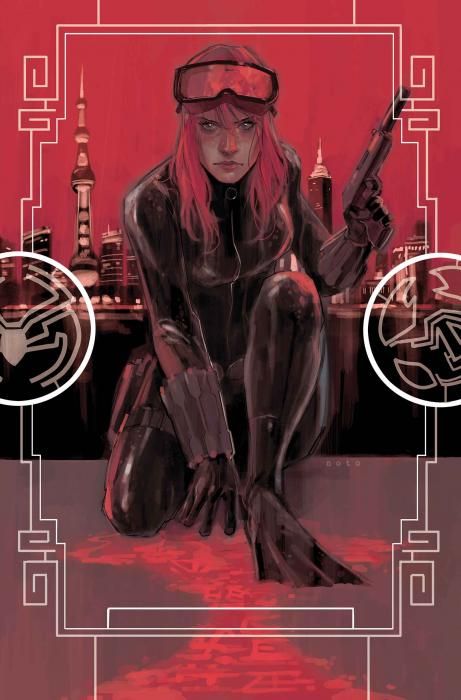In "Black Widow" #2, Nathan Edmondson and Phil Noto focus on Natasha's new solo mission of redemption, which leads her to Shanghai, but the real surprise for the reader is what occurs in her absence in New York.
Edmondson and Noto opens with Natasha's body flung head-first towards the reader, with threadlike, almost invisible, white action lines pointing away from the scene of a car collision. From there, he spins the timeline backward into a flashback to retrace Black Widow's steps towards Point Zero. It's a classic mystery and suspense timeline, so much so that the only real surprises are in the subplot.
The choice of China as a destination immediately re-establishes Black Widow as an international agent. Noto and Edmondson are not above using the foreign setting to add an exotic, slightly sinister tone. Natasha's antagonist sports a Manchurian queue hairstyle, not worn in China since the Qing dynasty, even though her friend, Mr. Lin, has a modern Western hairstyle. The choice of a foreign city as a setting, complete with a villain native to that city, also feels like a familiar genre move. Usage of "Shanghai" as a verb began in the 1850s, referring to the practice of kidnapping people to serve as sailors, referring to how the city was a common setting for these crimes of coercion. Edmondson's use of the word seems like a reach, referring simply to Natasha being taken off-guard.
In "Black Widow" #2, Natasha is like James Bond with long red hair, but with a graver sense of drive and purpose. Her voice doesn't yet have strong distinction from other solo operators. Edmondson and Noto's interpretation is more willowy and less sassy than Scarlett Johansson's role in "The Avengers" film that revived interest in the character, but the character's stated raison d'tre is the same: atonement. Natasha's thoughts dwell on her guilt in textbox voiceovers, and the story is about skeletons from her past, but the themes go no further than the surface and thus lack resonance. Edmondson may bring more depth to Black Widow's obsession with redemption in future issues, but for now, Natasha's guilt and desire for expiation functions more as a plot device than anything else.
The subplot around Natasha's lawyer, Isaiah, is more original, and its touches of humor make it feel fresh. Noto designed Isaiah to look like little more than a devoted white-collar suit. The contrast between his appearance and his actions, as well as Noto's black lines and red monochrome, make his actions in Black Widow's absence a pleasurable shock. There is real suspense around exactly what Isaiah's deal is.
Noto's art is lush and deliberate in composition and effect. The soft, painted look of the art creates a soft and hazy atmosphere. "Black Widow" is reminiscent of the "Crouching Tiger, Hidden Dragon" in its combination of action movie plotting and slow, art film-like visuals. Noto likes one color to dominate in scenes: yellow-gray sunlight for the opening few pages, orange sunset colors for her meeting with Mr. Lin, saturated green-blue and computer green for the water and boat scene. His palette carries a lot of emotion, especially in the red sequence for Isaiah that emphasizes the metaphorical and literal theme of blood.
The suspense and characterization are cookie-cutter at times, but overall, "Black Widow" #2 is a good read. It follows up smoothly on the events of the debut issue, and promises plenty of action and more development of the supporting cast in future issues.

